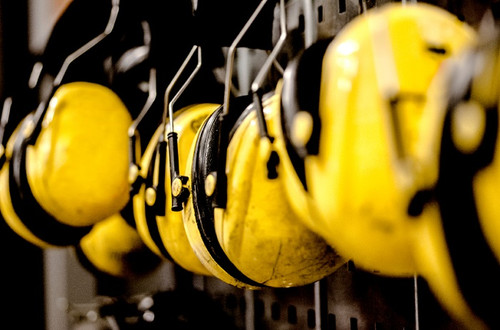A Sound Investment In Hearing Protection
Every year, approximately 30 million people in the United States are occupationally exposed to hazardous levels of noise according to OSHA. Since 2004, the Bureau of Labour Statistics has reported nearly 125,000 workers have suffered significant, permanent hearing loss. Surgery and hearing aids can only help with hearing loss, not correct it.
OSHA's permissible exposure limit (PEL) is 90 dBA for all workers for an 8 hour day. For each additional 5 dBA, the exposure time is cut in half. NIOSH identified construction, healthcare, and mining, as industries where employees are routinely at risk for noise exposure. Signs that your work environment may be too noisy include:
- Humming or ringing of the ears
- Needing to shout to be heard by someone standing next to you
- Experiencing temporary hearing loss when leaving work
Avoid permanent hearing loss by protecting yourself on the job or in hazardous environments.
Which hearing protector is right for me? The choice of hearing protectors is a personal one. When choosing, it's advisable to consider: level of noise, comfort, and fit for the environment. Manufacturers often provide a noise reduction rating (NRR) or the ability of a hearing protector to reduce noise. NIOSH recommends using fit data based on ANSI S12.6-1997 to determine the level of noise protection provided by a hearing protector. In lieu of fit data, NRRs can be adjusted (derated) to determine the noise reduction provided. For ear muffs subtract 25% from NRR, for formable earplugs subtract 50% from NRR, and for other earplugs subtract 70% from NRR.
When the noise exposure level in dBC is known, the effective A-weighted noise level (ENL) is: ENL [dB(A)] = Workplace noise level in dBC - derated NRR. When the noise exposure level in dB(A ) is known, the effective A-weighted noise level is: ENL = Workplace noise level in dB(A) - (derated NRR -7).
Common Types of Hearing Protection Ear plugs: When inserted, they block the ear canal. Small, comfortable and convenient. They can require time to insert and remove and hygiene must be considered if being reused. Ear plugs come in a range from basic to premium. One of our customers raves about the Moldex BattlePlugs Shooting Ear Plugs saying "I'm a Roller Derby referee and I am constantly blasting a fox 40 whistle as well as other refs. Those whistles hit 115-125 decibels which can damage an unprotected eardrum. Used these at the last game and not a single problem." Ear muffs: A headband with two cushions that fit over the ear, reducing noise. Ideal for intermittent noise as little effort is required to take on and off. They reduce noise less than ear plugs. They can be worn with minor ear infections. Ear muffs are less portable and can be inconvenient with glasses or in confined spaces. A PK Safety company favorite are the Howard Leight Sync Stereo Earmuffs because they double as headphones in addition to providing hearing protection. Hearing bands: A band consisting of two ear plugs held over the ends of the ear canal. The band may help the plugs stay in their intended place longer. Hearing bands are susceptible to breaking if sat on or placed underneath other objects. One hearing band to consider is the Howard Leight QB1HYG Hearing Band Ear Plugs. The sporty design ensures they wrap around your ears and stay in place while working. Hearing bands such as these are also nice because the ear plugs are replaceable while the band is reusable.
Be aware that removing ear plugs temporarily in a high noise environment reduces the maximum hearing protection provided. When you're all finished, clean your hearing protector based on manufacturer instructions in order to keep it hygienic and ready to use next time. The effects of hearing loss can be profound, as hearing loss can interfere with your ability to enjoy socializing with friends, playing with your children or grandchildren, or participating in other social activities you enjoy, and can lead to psychological and social isolation. We at PK Safety hope you will consider hearing protection the next time your workers or you are exposed to occupational noise.
Recent Posts
-
Promoting Safety: National Work Zone Awareness Week is April 15-19, 2024
Each year, the National Work Zone Awareness Week (NWZAW) places the spotlight on the importance o …Apr 11th 2024 -
Understanding 4 Gas Monitors: How They Work & Why They Are Important
In today’s increasingly dynamic industrial landscape, 4 gas monitors have emerged as critical com …Apr 8th 2024 -
April Showers Require Workers to Wear Hi-Vis Safety Rain Gear
While April showers bring May flowers, they also bring challenges, particularly for those working …Apr 1st 2024





